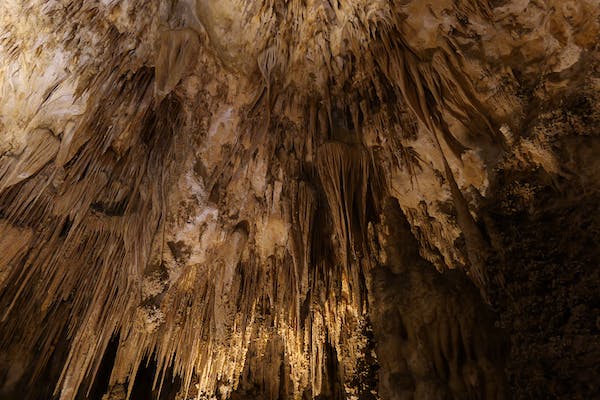Caves Situated in the Guadalupe Mountains of southeastern New Mexico, the park’s primary attraction is the show cave, Carlsbad Cavern.
Carlsbad Caverns is one of the oldest and most famous cave systems in the world. The caverns contain several vast underground chambers, up to 250 feet high, filled with amazing formations of many colors and shapes. It requires a full day’s drive from any of the other major attractions in the Southwest, but are well worth the long journey.
Enter the park at US Highway 62/180, nearly 18 miles southwest of Carlsbad, New Mexico. Carlsbad Caverns National Park partakes in the Junior Ranger Program and has two entries on the National Register of Historic Places: The Caverns Historic District and the Rattlesnake Springs Historic District.
Almost two-thirds of the park has been allotted for the wilderness area, ensuring no future changes will be made to the habitat.
Carlsbad Cavern includes a large cave chamber called the Big Room. It is a natural limestone chamber about 4,000 feet long, 625 feet wide, and 255 feet high at the highest point and is considered the third largest chamber in North America and the seventh-largest in the world.
History of the Park
About 250 million years back, the surrounding area where the park is located served as the coastline for an inland sea with abundant marine life whose remains formed a reef. The Permian reef is not like modern reef growth because it contained bryozoans, sponges, and other microorganisms.
At the end of the Permian period, most of the water evaporated, and the reef was buried by evaporates and other sediments. Tectonic movement occurred during the late Cenozoic, uplifting the reef above ground. Susceptible to erosion, water formed the Guadalupe Mountain region into its present-day state.
The area was home to nomadic Native American tribes 13, 000 years ago. During the 16th century, Cabeza de Vaca was the first Spanish pioneer to cross southeastern New Mexico in 1536. Throughout the 18th-20th century, commercial exploits in the area have increased.
Between 1915 and 1918, Ray V Davis, an American photographer, has captured the extensive underground system. His photographs attracted historians and tourists to see the actual view of the place during the 20s that marked the beginning of life as a significant tourist attraction.
In 1923, the Carlsbad Cave declared a National Monument and became a National Park after seven years, intending to protect and preserve the largely uninhabited cave system.
Other Caves
The park houses over 119 caves, and three are open to public tours. Aside from the most famous Carlsbad Caverns, the Slaughter Canyon Cave and Spider Cave are also visited despite being undeveloped, exceptfor designated paths for the guided “adventure” caving tours.
Lechuguilla Cave is famous for its delicate speleothems and pristine underground environment. But in the 1910s, Guano mining occurred in the pit below the entrance. However, cavers broke into a room in 1986 when the national park managers permitted to dig into a rubble pile, and the wind whistled between the rocks and the weather tremendously changedunfavorably.
Over 120 miles of cave passage has been explored and mapped to 1,600 feet (490 m) depth, making it the second deepest limestonecave in the U.S. Access is limited to permit scientific expeditions only to protect the cave’s fragile environment.
Activities at the Park
Bat Flight Breakfast
There are various bats in the Cavern. There are around 400, 000 resident colony during summer in 2005 but in the spring and fall migration, the bat numbers in the cavern were documented as high as 793,000.
There is a bat flight breakfast held annually sponsored by park employees, usually on the second Thursday in August, from 5:00 am to 7:00 am. It aims to encourage visitors to watch the bats as they return to the cavern.
Hiking/Backpacking
Being isolated, the park has an incredible diversity of plants and animals. Enjoy a short walk along any park trail that provides enriching experiences. Most of the trails are marked only by rock cairns (rocks piled or stacked into a noticeable heap), so it’s advised to use a topographic map.
The King’s Palace
It has a stunning large castle-like formation in the center of the 100 feet tall room; that is why it is called the King’s Palace, and it is the first of four chambers in a cavern wing known as the beautiful rooms.
While inside the King’s palace, you will know the history of the area discovering Carlsbad Cavern. You can also enjoy taking photos.
The Rattlesnake Springs
Rattlesnake Springs is an essential part of American Indians and later ranchers in the area. It was purchased and now used by Carlsbad Caverns National Park for the water.
Locating the entrance is accessible. You can drive little ways down until you come to the large grassy picnic area.

